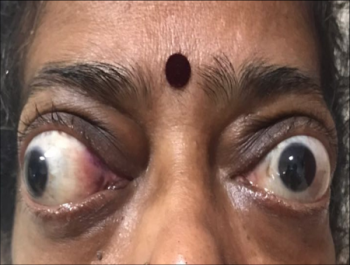A 45-year-old female patient suffering from Graves's disease presented with dryness, blurring of vision, and protrusion of her eyes for 2 months. Ocular examination revealed bilateral proptosis with the widening of the palpebral fissure and retraction of both upper and lower eyelids (Dalrymple's sign) (Figure 1). She also had upper lid lag on looking down (Von Graefes sign), lower lid lag on looking up (Griffith sign), deficient convergence (Mobius sign), and infrequent blinking (Stellwag's sign). In addition, there was decreased visual acuity and restriction in extraocular movements in both eyes. The patient was started with carbimazole and propranolol, lubricating eye drops, gel, and intravenous methylprednisolone pulse therapy. At 3 months, follow up her thyroid profile was normal and proptosis had reduced.

Figure 1. Patient with bilateral proptosis and widening of the palpebral fissure and retraction of both upper and lower eyelids (Dalrymple's sign).
Graves ophtalmopathy (GO) is the most common extrathyroidal manifestation of Graves' disease (GD) characterized by immunological to the thyroid-stimulating hormone receptor (TSH-R) [1]. Most patients are hyperthyroid. However, some may be euthyroid. The incidence of GO is 16 women or 3 men per 100,000 person per year. The pathogenesis comprises (1) inflammation of the periorbital soft tissues; (2) overproduction of glycosaminoglycans by orbital fibroblasts; and (3) hyperplasia of adipose tissue.2 The extracellular matrix rich in glycosaminoglycans makes it highly hydrophilic, increasing its capacity to retain water making the extraocular muscles swell dramatically. In addition, adipogenesis also results in increased orbital tissue volume [2]. There are two stages in the natural history of GO: the first one is the active stage, observing an increased inflammation and rapid progression; it is followed by an inactive phase (second stage) in which the inflammatory signs and symptoms gradually reduce. However, the muscular edema along with increased production of collagen ultimately lead to fibrosis and sclerosis resulting in restrictive strabismus, proptosis and persistent lid retraction. The treatment depends on the stage, in the active stage anti-inflammatory treatment with glucocorticoids, cyclosporine, or mild low dose radiation is carried out, in sight-threatening cases orbital decompression should be carried out [3]. In the inactive stage, rehabilitative surgery like eyelid and strabismus correction can be done [2].














